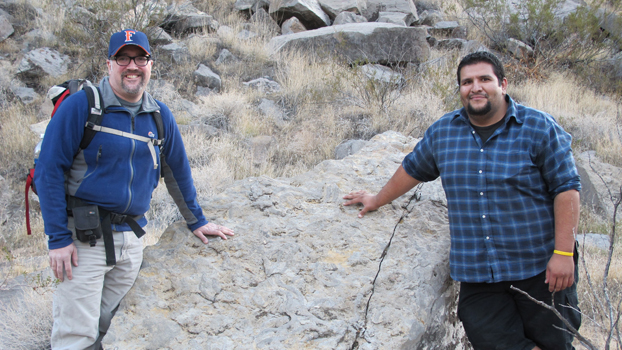 Caption: Geology graduate student Pedro M. Monarrez, right, conducted research during the summer in the desert near Las Vegas. The resulting poster won Monarrez an Outstanting Student Poster Award from the Paleontological Society. At left is Monarrez's project adviser, Adam D. Woods, associate professor of geological sciences.
Caption: Geology graduate student Pedro M. Monarrez, right, conducted research during the summer in the desert near Las Vegas. The resulting poster won Monarrez an Outstanting Student Poster Award from the Paleontological Society. At left is Monarrez's project adviser, Adam D. Woods, associate professor of geological sciences.
University STEM Initiative
Geology Student Wins Paleo Award
Research Efforts Focus on Global Mass Extinction
Geology graduate student Pedro M. Monarrez spent the summer working and sweating in the desert northeast of Las Vegas, but the results were worth it: his research project “Late Mississippian Brachiopod Community Response to the Onset of the Late Paleozoic Ice Age, Arrow Canyon, NV,” won an Outstanding Student Poster Award from the Paleontological Society.
“It’s very exciting, and it's a great honor to be recognized by the Paleontological Society, which is an international organization devoted to the advancement of paleontological research,” said Monarrez, who earned a bachelor of science degree in geology in 2009 from Cal State Fullerton and plans to complete the master’s program in geology this spring.
His research — on shelled invertebrates called brachiopods that lived in the area 325 to 320 million years ago — was presented at the October Geological Society of America meeting in Minneapolis, Minn.
Monarrez’s research and presentation at that meeting “... were extremely well done, and the reviewers who evaluated the poster gave it perfect marks in the various categories included in the judging process,” said the organization’s award coordinator.
Monarrez credits his project adviser, Adam D. Woods, associate professor of geological sciences, for helping him achieve the national kudos. “Dr. Woods has been a tremendous mentor who forces me to think outside of the box when tackling research problems, which is what spurred the idea for this particular study.”
Woods called Monarrez “passionate and self-motivated about doing science. He is a wonderful example of the types of success stories that come out of Cal State Fullerton. Pedro has a very bright future ahead of him.”
Woods noted that Monarrez's project shows that mass extinctions are complicated.
“Some areas suffer more than others during extinction events, and Pedro’s research shows that parts of the West Coast of North America not only fared well during the mass extinction at the Mississippian-Pennsylvanian boundary (about 318 million years ago), but thrived.”
Monarrez, whose study will be incorporated into his thesis, explains his research and its significance.
What is the significance of this area?
The rocks in Arrow Canyon record the onset of an ice age known as the Late Paleozoic Ice Age, which was the longest ice age of the past 550 million years — lasting approximately 50 million years. The brachiopods, which appear in the rocks that record the onset of the ice age, are not found in rocks below this interval in Arrow Canyon, which represent a time when the climate was warmer. Additionally, the number of different brachiopod species increased as the ice age progressed.
What does your study show?
I analyzed the latitudinal distribution of the brachiopods from the Paleobiology Database, an online fossil occurrence database, to try and understand what was causing new brachiopod species to appear as the climate cooled. I found that the types of brachiopods in my study covered a large latitudinal distribution, evenly distributed along the southern hemisphere prior to the onset of the ice age. But during the onset of the ice age, the same types of brachiopods exhibited a much smaller latitudinal distribution, focused on the tropics just south of the equator, which is where my field site was situated 325 to 320 million years ago. So as the climate cooled, we interpret that these brachiopods migrated north towards the equator in search of warmer environments.
What is the significance of the study?
This study has implications to modern conservation efforts by providing modern ecologists insight that may aid in predicting how modern communities will respond in the midst of the current climate change.
What is your career goal?
My career goal is to continue conducting paleontological research, ideally in an academic setting, where I can mentor students. I am currently applying to Ph.D. programs so I can continue conducting research to help me reach my ultimate goal.
Dec. 16, 2011
